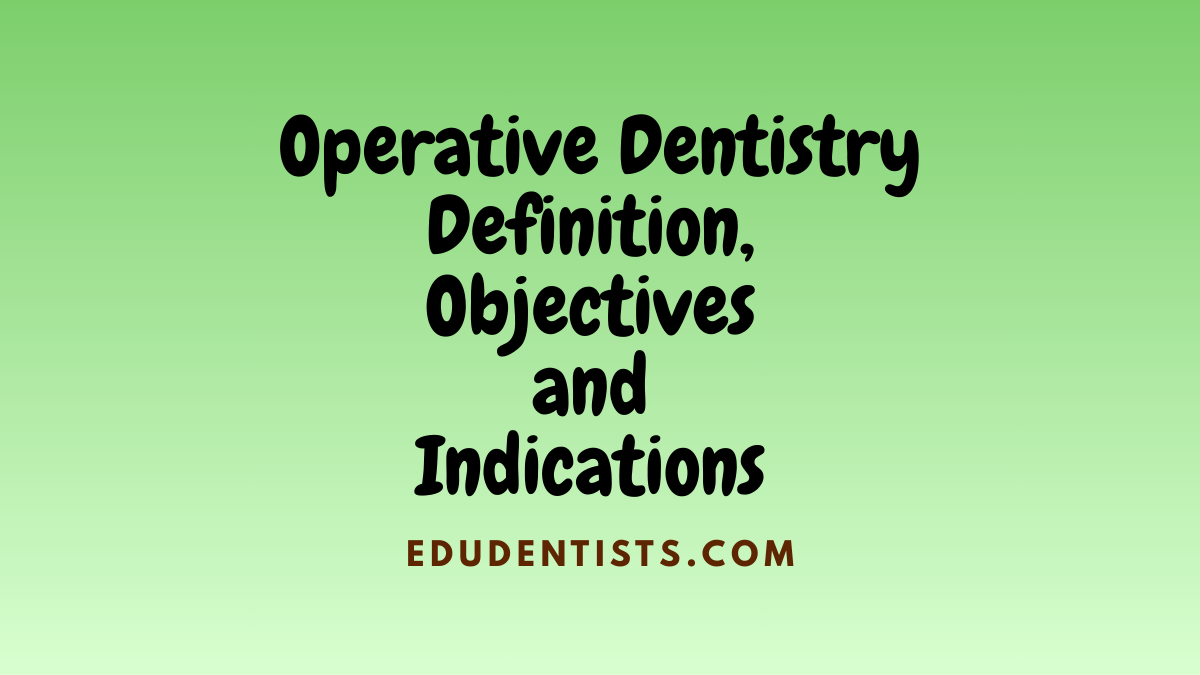
Operative Dentistry
Definition of Operative Dentistry
- Operative dentistry is that branch of dentistry which based on art and biomechanical science.
- Operative dentistry is that branch of dentistry which deals with the esthetic and functional restoration of the hard tissues of individual teeth.
- Operative dentistry includes all procedures necessary to eliminate the lesion, provide a biomechanically compatible room for accommodation and retention of a synthetic restorative material for the lost tooth structure. It is practiced in sequential phases aiming to achieve total patient treatment rather than a “drill and fill” policy.
Phases of Operative Dentistry
- First phase is concerned with diagnosis and clinical assessment of the patient. This includes all relevant information about the patient, including age, occupation, general health, dietary habits, caries activity, home-care and socio-economic status. It also involves identification of the type and extent of the original insult of caries, erosion, attrition, traumatic fracture, hypoplasia, discoloration or changes of tooth form, size, position, alignment or occlusion.
- Second phase is devoted to outlining the treatment plan in logical sequential steps of procedures. From the previous diagnostic phase, selection of the appropriate restorative material (s) is made and determination of any possible cooperation of other allied disciplines such as endodontics, periodontics, orthodontics or maxillofacial surgery is determined.
- Third phase concentrates on execution of operative procedures to eliminate the lesion and provide the necessary preparation that accommodates the selected restorative material.
- Fourth phase is the restorative phase which is concerned with construction of the restoration and application of cavity liners/bases. The operative and restorative procedures should be based on well established scientific mechanical, biological and esthetic fundamentals.
- Fifth phase deals with regular follow up and maintenance of existing restorations and the general health of the dentition. Preventive treatment should be implicated and home care encouraged.
Objectives of Operative Dentistry
Restorative treatment is not limited to the synthetic substitution of lost hard tooth structure but it includes a program for control of the attacking mechanism with provisions for restoration of an integral masticatory system to normal health, functional efficiency and harmonious esthetics and function.
This is done through application of accepted and cross-linked biological, mechanical and esthetic basic fundamentals.
1. Restoration of health for the affected tooth:
Operative dentistry involves preventive and restorative methods for elimination of the lesion and its influence, reproduction of lost tooth structure and establishing full control on the attacking mechanism.
This objective requires:
A. Complete elimination of defective tooth structure.
B. Preservation and protection of the remaining tooth structure; this involves:
* Mechanical protection of tooth structure against fracture, including preparing conservative cavity design with its margins free from caries, discoloration, weakened tooth structure and placed at areas of less stress.
* The restoration should be able to produce and maintain a leak-proof sealed margins which are cariostatic and biologically compatible.
* All operative and restorative treatments should be biocompatible with the pulp-dentin organ.
| Application of an anti-caries program; the patient should maintain good oral hygiene and an anti-caries program should be applied for protection against recurrence of caries , including regular fluoride application and correction of dietary habits. |
2. Restoration of normal occlusion and efficient mastication:
– Efficient mastication demands a restoration which establishes and maintains proper occlusal anatomy, axial contour and inter-proximal contact without any occlusal interferences or anatomic departures from the normal anatomic landmarks.
– In addition, the restoration should be form stable, securely retained in place and sufficiently strong to sustain the multiple types of mastication forces without fracture, distortion, loss of substance or change of surface texture.
– It should also be biocompatible with the tooth structure with no irritation on the adjacent or remote tissues of the masticatory system including the teeth, investing tissue, muscles of mastication and TMJ.
– The patient should be able to enjoy comfortable mastication without problems of food impaction, hypersensitivity or pain or development of abnormal occlusal or biting positions.
3. Restoration of esthetics:
– The demand for esthetic appearance of the dentition is becoming a major concern in the modern dentistry to the extent that some patients give it priority to physical properties if compromise becomes necessary.
– Restoration of esthetics requires that the defective tissues are eliminated and reproduced to exact harmonious color, size, form, translucency and surface texture with correction of any minor abnormalities of occlusion, alignment and inter-arch articulation.
Indications of Operative Dentistry
The indications for operative procedures are numerous. However, they can be categorized into three primary treatment needs:
1. Caries.
2. Malformed, discolored, nonesthetic, or fractured teeth.
3. Restoration replacement or repair.
4. These operative and restorative procedures are based on well established scientific mechanical, biological and esthetic fundamentals. Skillful application of these principle fundamentals is essential for the successful achievement of the objectives of operative dentistry.